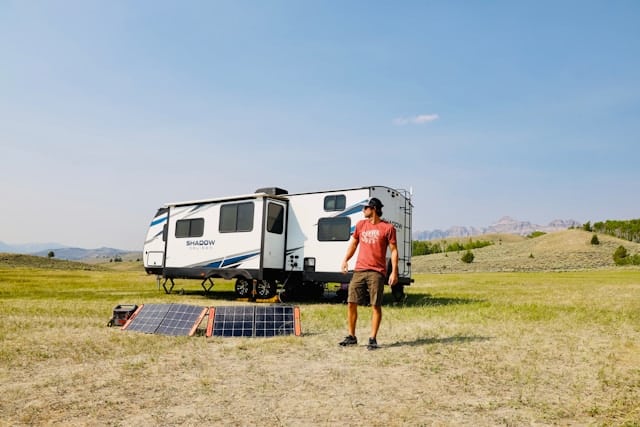How to Install a Solar Panel on an RV for Off-Grid Electrical Needs?

In an age of increasing environmental awareness and technological advancements, one can integrate clean energy solutions even while on the move. Installing solar panels on a recreational vehicle (RV) transforms your mobile abode into a self-sustaining, off-grid electrical hub, an excellent way to reduce carbon footprints while enjoying the freedom of the open road.
Understanding Solar Power Systems for RV
Before we delve into the installation process, it’s crucial to understand what a solar power system for RV entails. This encompasses solar panels, batteries, a charge controller, an inverter, and the necessary wires to connect all these components.
En parallèle : What’s the Optimal Tire Pressure for a Track Setup on a Chevrolet Corvette Z06?
Solar panels absorb sunlight and convert it into Direct Current (DC) electricity. The charge controller manages the power going from the panels to the battery, ensuring it doesn’t overcharge. The accumulated energy in the batteries is also in DC form, which the inverter converts into Alternating Current (AC) electricity. AC electricity powers your RV’s systems and appliances.
Choosing the Right Solar Panel
When opting for solar power, choosing the right panel is vital. There are several factors you need to consider: the amount of power you will need, the space available on your roof, and the type of panel that suits your needs.
A voir aussi : Can a Sequential Gearbox Improve Lap Times in a Honda NSX on a Road Course?
Monocrystalline, polycrystalline, and thin-film are the three main types of solar panels. Monocrystalline panels are the most efficient but also the most expensive. Polycrystalline panels are slightly less efficient but more affordable, while thin-film panels are the least efficient but the most space-friendly.
In terms of power, tailor your choice to your energy consumption. Consider the appliances you use, how often you use them, and the number of days you plan to be off-grid. This will help you gauge the energy you need and thus, the size and number of panels required.
Preparing for Installation
Preparation involves measuring the available space on your RV’s roof and planning the layout of the panel(s). Dimensions of a standard solar panel range from 65 inches by 39 inches for large panels, to 39 inches by 26 inches for smaller ones.
You will also need to purchase or prepare a mounting system. This is what will hold the panel(s) in place on the roof. There are several types of mounts, such as fixed mounts, tilt mounts, and tracking mounts.
Remember to consider the route of the wires from the panel to the batteries. Ensure this path is safe and as direct as possible to reduce energy loss.
Installing the Solar Panel
The primary steps involved in installing the solar panel on your RV include mounting the panel on the roof, connecting it to the charge controller, connecting the controller to the battery, and finally connecting the battery to the inverter.
For mounting, place the panel on the roof in your planned layout. Ensure it’s secure and stable. Once the panel is in place, connect it to the charge controller. This process involves running the positive and negative wires from the panel to the controller.
The next step involves connecting the charge controller to the battery. Here, you need to ensure you maintain the correct voltage level. Most RV systems run on a 12-volt battery system. Therefore, make sure your controller, panel, and battery are compatible in terms of voltage.
The last step is connecting the battery to the inverter. This is done via a fuse for safety purposes. The inverter will then convert the DC electricity stored in the battery into AC electricity for use in your RV.
Maintenance and Troubleshooting
Once your solar panel system is installed, it’s essential to maintain it properly to ensure it continues to provide power efficiently. Regular cleaning of the panels is necessary as dust or debris can affect their efficiency. Also, make sure to check the system’s voltage regularly to ensure it’s functioning correctly.
If you face any issues with your solar power system, the first thing to check is the connections. Ensure all wires are securely connected and not damaged. It’s also important to check the charge controller’s display to see if the panel is generating electricity as it should.
Installing a solar panel system for your RV is a significant step towards sustainable living. It offers independence and flexibility, especially for those who love the freedom of being on the road. By understanding the components of the system and the installation process, you’re well on your way to harnessing the sun’s power for your RV.
The Benefits and Limitations of RV Solar Power Systems
Having a solar power system installed in your RV comes with a multitude of benefits. Primarily, its ability to provide a self-sustaining power source minimizes reliance on power grids or generators, and thus, reduces your carbon footprint. Having a solar system means you can camp anywhere without worrying about electrical hookups. It is also quiet and non-polluting, unlike a generator.
Opting for solar power also significantly cuts down on electricity costs in the long run. With an effectively designed and installed system, you can provide enough power to meet your everyday electrical needs. This includes powering appliances, lighting, and even charging your electronic devices.
However, there are some limitations. Solar power is, of course, dependent on sunlight. Therefore, the amount of power you can generate is influenced by weather conditions and the time of year. Additionally, the initial investment for a solar power system can be quite hefty, even though it pays for itself in the long run.
Conclusion: Embrace Solar Power for Your RV
To summarize, installing solar panels on your RV is a forward-thinking move that marries sustainability with the freedom of the open road. It offers a clean, quiet, and cost-effective solution for your off-grid power needs.
Understanding the components that make up the solar power system, such as the solar panel, charge controller, and battery bank, is key to knowing how the system operates. Determining the right kind and size of solar panels is essential for matching your energy consumption. The installation process, while seemingly complex, can be straightforward with careful planning and execution.
Proper maintenance, notably regular cleaning and checking of voltage levels, is paramount to ensure the longevity and efficiency of your solar power system. Being able to troubleshoot common issues, such as checking connections, can save you time and stress.
By harnessing the power of solar energy, you will not only contribute to a greener earth but also enhance your RV’ing experience. So whether you like to camp in the wilderness or simply enjoy the flexibility of portable power, a solar power system can revolutionize the way you experience the great outdoors. Embrace the sun’s energy, turn your RV into a power station, and enjoy the benefits of off-grid living.
